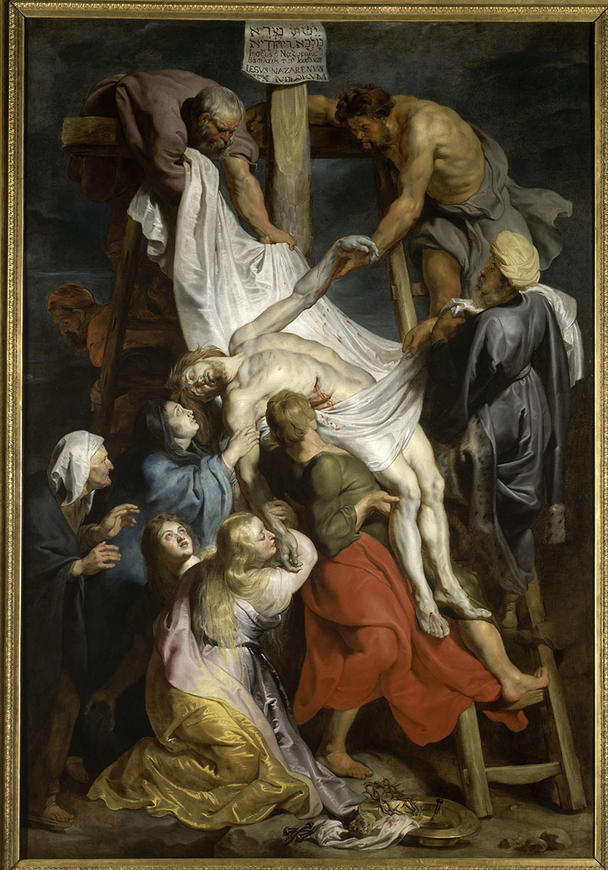This monumental work was painted for the high altar of the chapel of the Capuchin monastery in Lille, which is now no more. Several works were commissioned from the Antwerp master when the chapel was enlarged in 1615.
The chosen episode is often used to decorate high altars, where Jesus's sacrifice is celebrated. But here, the subject is for the first time treated as a realistic event: people are taking down a dead body from a cross! Look at the palette Rubens used: the cold tones of the crucified flesh, which contrast with the warm complexions of the other protagonists. Only the face of Mary, depicted close to her son's face, shares the same... cadaverous hues.
In this masterpiece, the ritual dimension is less important than the description of physical death and sorrow.
How does Rubens manage to grab us emotionally? The power of this image lies essentially in the composition and the quality of its execution: an uninterrupted sequence of arms, hands and faces forms a repeating pattern punctuated by intense facial expressions. In the centre of the painting is Jesus's gaping wound. The powerful figures, the bold colours and the anatomical realism render the event even more tangible. Finally, the figures outside the scene – the elderly woman to the left in the foreground, the man in red climbing down the ladder – are our guides as we witness the unfolding drama.
Detail 1:
In the foreground, the instruments of the Passion (crown of thorns, nails, vinegar-soaked sponge), the legs of the ladder and the folds of Mary-Magdalene's robe make up a splendid still life.
Detail 2:
This sketch is probably a study for the definitive composition. Thanks to a restricted technique and palette, the artist targets the crucial elements and rapidly assesses the potential of the composition.
Inv. P 74

This monumental work was painted for the high altar of the chapel of the Capuchin monastery in Lille, which is now no more. Several works were commissioned from the Antwerp master when the chapel was enlarged in 1615.
The chosen episode is often used to decorate high altars, where Jesus's sacrifice is celebrated. But here, the subject is for the first time treated as a realistic event: people are taking down a dead body from a cross! Look at the palette Rubens used: the cold tones of the crucified flesh, which contrast with the warm complexions of the other protagonists. Only the face of Mary, depicted close to her son's face, shares the same... cadaverous hues.
In this masterpiece, the ritual dimension is less important than the description of physical death and sorrow.
How does Rubens manage to grab us emotionally? The power of this image lies essentially in the composition and the quality of its execution: an uninterrupted sequence of arms, hands and faces forms a repeating pattern punctuated by intense facial expressions. In the centre of the painting is Jesus's gaping wound. The powerful figures, the bold colours and the anatomical realism render the event even more tangible. Finally, the figures outside the scene – the elderly woman to the left in the foreground, the man in red climbing down the ladder – are our guides as we witness the unfolding drama.
Detail 1:
In the foreground, the instruments of the Passion (crown of thorns, nails, vinegar-soaked sponge), the legs of the ladder and the folds of Mary-Magdalene's robe make up a splendid still life.
Detail 2:
This sketch is probably a study for the definitive composition. Thanks to a restricted technique and palette, the artist targets the crucial elements and rapidly assesses the potential of the composition.
Inv. P 74